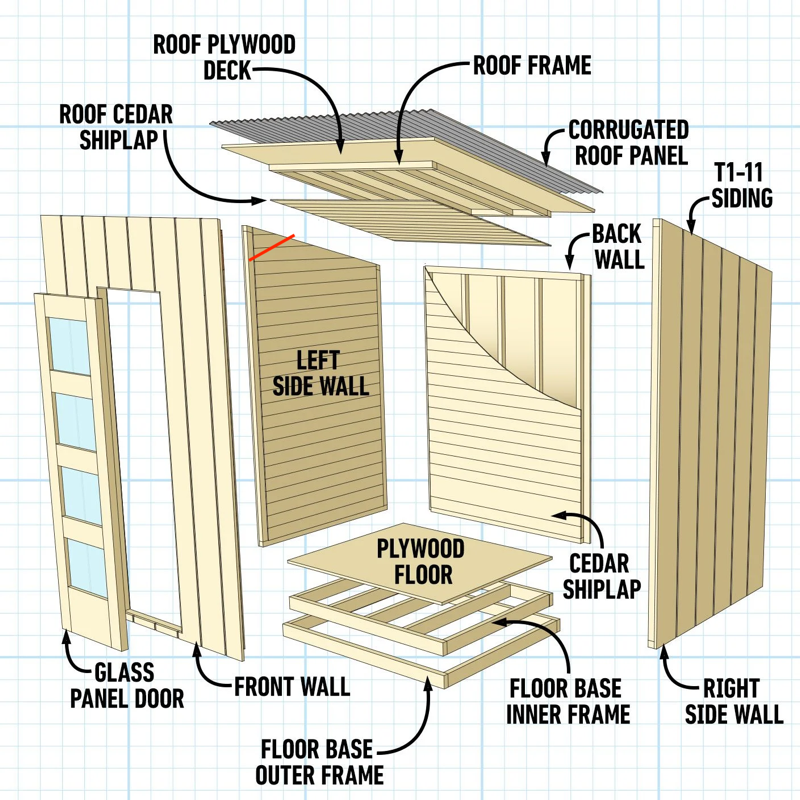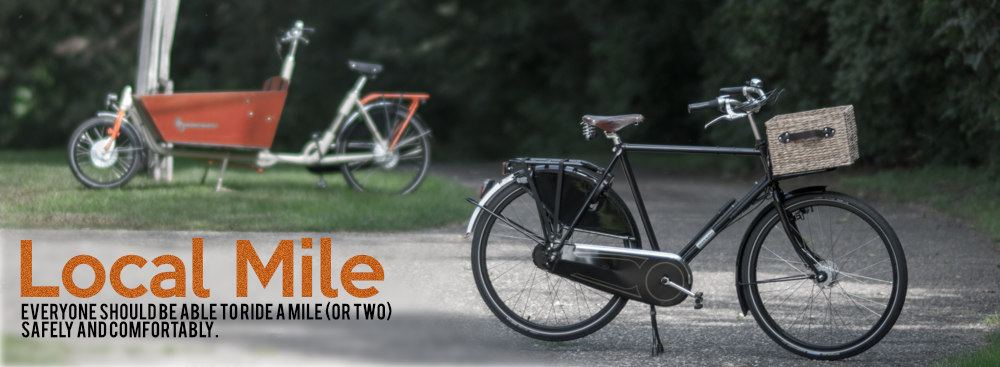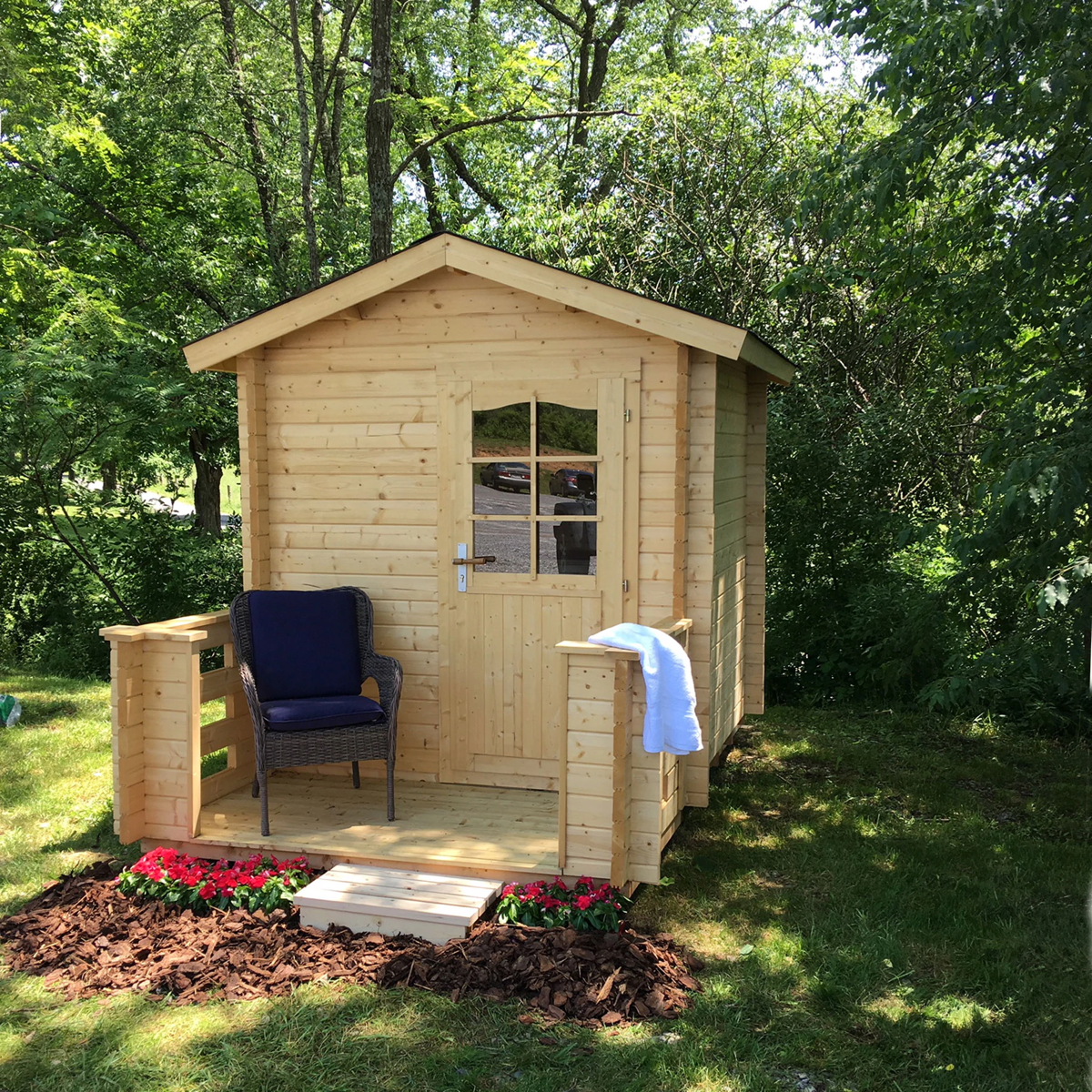Following are reviews of a sampling of kit saunas available in North America, UK, and OZ. These reviews are based on the functional design and how they compare to basic sauna design principles (see the TL;DR at the beginning of Trumpkin’s Notes on Building A Sauna).
Most kits available in the english speaking world are poorly designed – too small, too low of benches, poor ventilation, no commons/changing and other problems.
You don’t see kits like these in Finland or other countries because they understand better how saunas work and how to build them, the importance of height and overall volume, good ventilation and air gaps in benches, etc. Things that are critical for a more enjoyable experience.
This will give you an idea of some entry-level kit saunas offered in Finland. And in Norway. And even these are sometimes criticized for having too low of benches, too small of changing areas, too much glass, and other things but they are still much better than kits available in the U.S.
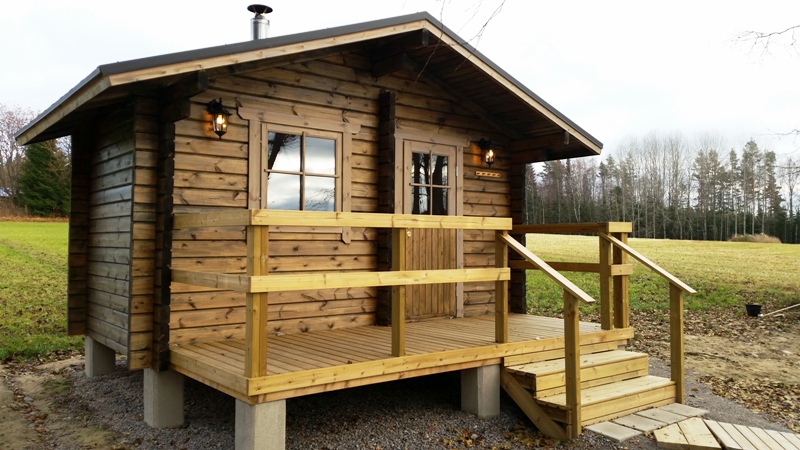 Sauna Kit ‘Sara’ by Joro-Huvilat.
Sauna Kit ‘Sara’ by Joro-Huvilat.
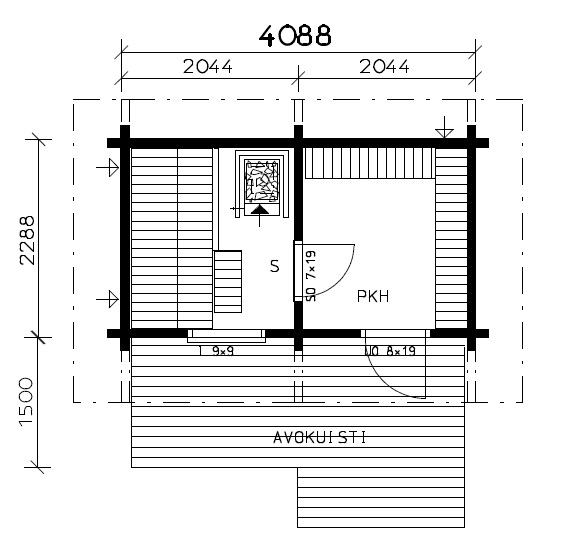 Sauna Kit ‘Sara’ includes the minimum essentials; sauna hot room, commons area and porch. Note that this is the smallest kit offered. They understand the importance of a proper sized sauna hot room as well as a commons/changing area so most kits are larger.
Sauna Kit ‘Sara’ includes the minimum essentials; sauna hot room, commons area and porch. Note that this is the smallest kit offered. They understand the importance of a proper sized sauna hot room as well as a commons/changing area so most kits are larger.
While most of the kits currently available in the U.S. make for rather poor saunas, there are an increasing number that offer a better and more real sauna experience. That said, even that bad are often better than a barrel. If an ideal sauna is a 10 then almost every sauna built to Finnish design principles (maybe 80-90% of saunas in Europe or ≈ 20 million) will be maybe 8-9, an average custom sauna in the U.S. perhaps a 3-4, kits like these a 2 or 3 and barrels a 1 or 2. It is possible to build kits that make good saunas that would score 6-9 but unfortunately nobody in North America has yet chosen to do that.
Anyone considering a kit should give consideration to how long they’ll use it. These are not as comfortable nor enjoyable as a real sauna. Due to the poor quality saunas (and sauna practices) in the U.S. sauna has a very high abandonment rate – people use them for a year or three until the novelty wears off and then stop using them. A proper sauna provides a compelling experience that people find enjoyable for life.
For a better understanding of sauna and what is critical for a good sauna see ‘Intro to Sauna’ and ‘Notes on Building a Sauna’ in the menu above as well as Lassi Liikkanen’s book ‘Secrets of Finnish Sauna Design’.
Health/Wellness/Recovery Benefits – If achieving any health benefits, such as improvements to your cardio or immune system or recovery after a workout, is important to you then keep in mind that these kits may not deliver those benefits due to low benches, uneven heating, poor steam and high CO2 levels. Heating just your head and upper body, as most U.S. kits do, may not provide any recovery benefits for instance.
Recent technology and studies are providing us with some objective data on efficacy as shown below. Note that the Finnleo kit (orange line) is below even a hot tub and bio-sauna. In the coming months we should gain considerably more insight in to how various design elements affect physiological response.
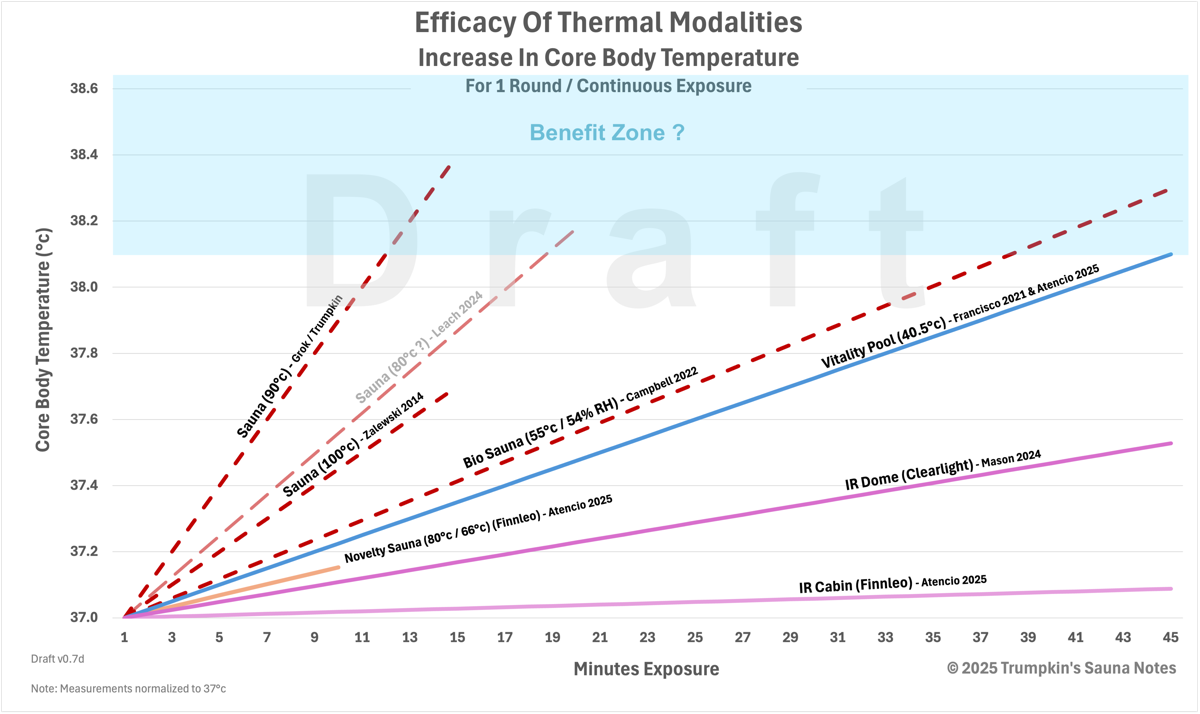
Post-Purchase Rationalization – There are a lot of people who’ll say that they bought such and such kit and love it. Often this is indeed true. Two things to consider here. In the vast majority of cases these are comments from people who have never experienced a real sauna. Further, these comments are often made while the sauna is a new and novel experience, before it’s fallen to disuse because it’s not that great of a sauna.
And sometimes they are not being so truthful. They spent, or wasted, a bunch of money and want to rationalize their purchase.
Buying A Kit in North America
First, here are some critical things to look for: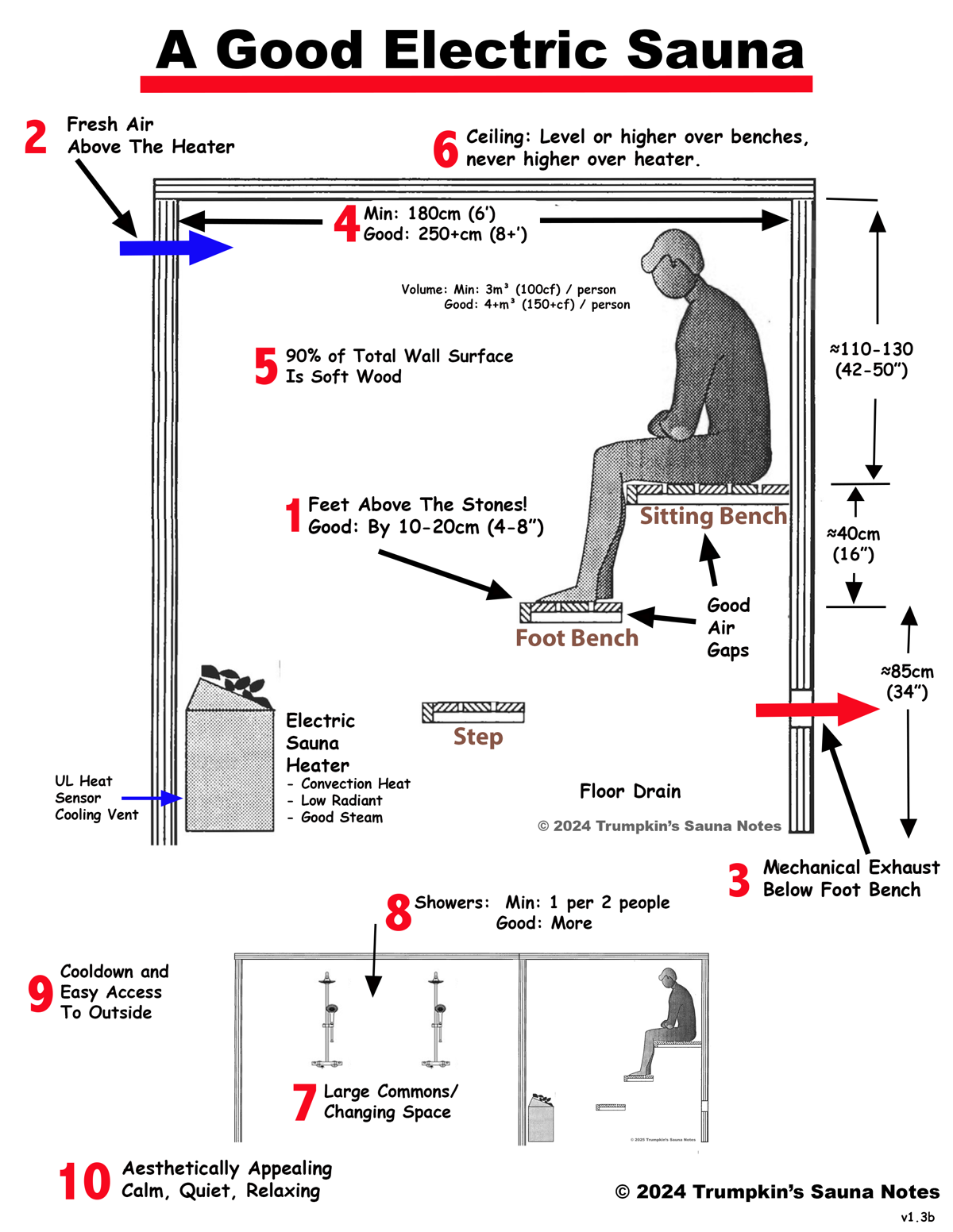
Unlike in Finland and elsewhere, there are currently no well designed kits available in North America. But there are a few who are progressing in the right direction:
For those in or near Canada this Cabin Kit from Knotty Sauna Co. might be a worthwhile option to consider (and is one of the best kits I’ve seen in North America). You’ll need to do the heater and ventilation yourself but this should at least provide a good structure which I believe is the biggest challenge for most people. It’d be nice if they’d also offer a commons/changing area that can be added on.
Cedarbrook were the first to offer an option that leaned towards complying with Finnish standards and from what I understand have produced a few custom kits that are an improvement on this option.
A new startup, Mune Sauna, has introduced their first V1 Sauna and I understand are working on a V2 that will include some critical improvements. They are worth keeping an eye on.
Timber Sauna Co are now offering at least one sauna built to Trumpkin specs.
Custom Kits – Some manufacturers have been agreeing to modify their kits to comply better with Finnish sauna principles as outlined in Trumpkin and ’Secrets of Finnish Sauna Design’. I think a kit can be a good lower cost option if designed and built correctly so this is something that may well be worth pursuing for those interested.
Almost Heaven I, Almost Heaven II, Finnleo and Cedarbrook have all been mentioned as being willing to build kits to Trumpkin/Secrets/Finnish guidelines so perhaps start with them. Be careful though – in two cases companies agreed to build a true Finnish sauna to Trumpkin/Secrets guidelines but then produced drawings indicating that they clearly still don’t get it or understand how a sauna works.
Ask for temperature measurements. Ask kit manufacturers for the head to toe temperatures of the sauna you are considering. This is the most critical element that cannot be fixed. Any sauna builder who cares at all about quality will have a two or four probe digital logging thermometer and should be able to provide at least what these temps are once heated but ideally a line chart showing heat up and use including door opening.
Deceptive Advertising – There is perhaps no better evidence of the decline of America than the snake oil of the U.S. sauna industry. For more see Quackery and Sauna Frauds in the top menu.
Common Mistakes
There are three critical elements that it seems few kit manufacturer’s in the english speaking world understand.
1) “Feet above the stones” is The First Law Of Löyly. And for good reason. Sauna is about very even heat and steam; head to toes, front to back and minute to minute. Hot air rises, the convective loop that creates the löyly cavity is above the top of the stones which results in less stratification and makes this critical to a sauna experience (and to good hygiene). Finns do not want a sauna with a foot bench that’s too low – below the top of the stones or down in the cold zone (bottom third of the space) unless space constraints allow no alternative. If your feet aren’t above the stones or at least 34” above the floor then you are, for the most part, not in a sauna.
2) Proper ventilation is needed to help us breathe. Otherwise we begin to feel the effects of suffocation from too much CO2 (such as feeling lightheaded, dizzy, etc.). Proper ventilation is also needed for removal of moisture, odors, VOC’s and pathogens as well as lessening heat stratification. For electrically heated saunas this must include a fresh air supply vent above the heater and a mechanical powered exhaust below the foot bench. Natural convection, as these kits have, is for heater over temp sensor cooling and does not provide ventilation for bathers. Saunas, which can have quite high humidity, should vent to outside. A kit sauna that vents to the inside of a home can result in too high of humidity leading to mold growth and other problems.
Ventilation is fixable though. Many people have followed the advice here and installed a mechanical exhaust under the foot bench with a fresh air supply above the heater and seen noticeable improvement in air quality and less heat stratification.
3) Size and Interior Volume. A hot room of less than about 6’ x 6’ or with a heater wall to bench wall of less than about 6’ will often not develop a proper convective loop. Bathers are likely to experience harsher heat rising in to their face rather than gentler convective heat descending down from the ceiling as it should. Radiant is more likely to be a problem as well. A sauna should have an absolute minimum of 105 cubic feet of interior volume per person plus an additional 35 cubic feet. This is for healthy air to breath. Sauna builders in Scandinavia often aim for twice that amount of interior volume per bather. Less volume results in people rebreathing too much of their own and others exhaled breath and so high CO2 and pathogen levels.
Note: If you find a kit that is built correctly then please let us know. It would be great to have something that can be recommended.
Consider A Saunum
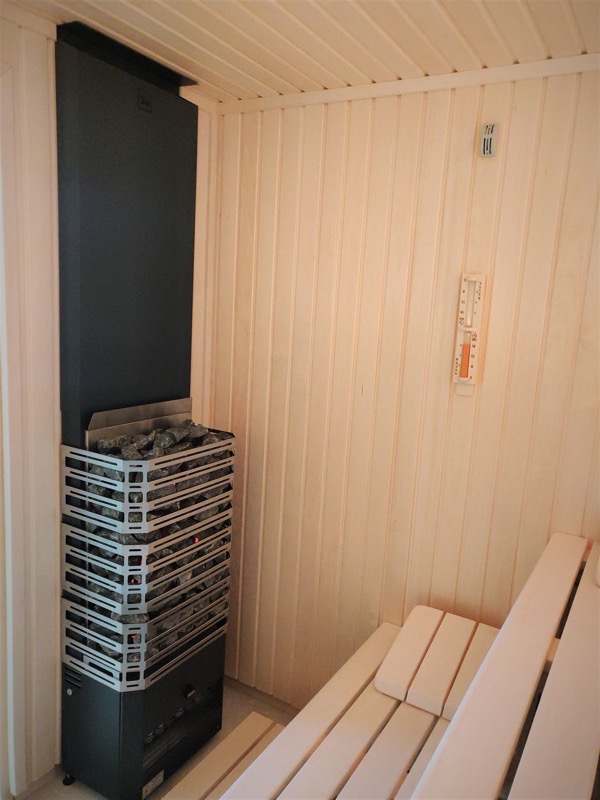
The Saunum is a device that mixes the air and moisture in a sauna to reduce heat and steam stratification. It works well in saunas with too low of ceilings and benches to somewhat approximate the experience of a proper sauna with an 8.5’ or higher ceiling. A higher ceiling and benches is still best but if that’s not possible then a Saunum is likely the better alternative.
For perspective, the consensus out of Finland and Germany seems to be that a Saunum can achieve perhaps a 6 or 7 grade of sauna so much better than a 3 or 4 but not as good as the 8-10 of real saunas. Some have also complained about the noise from the blower.
A Saunum helps primarily only with temperature stratification. It will help to mix air in a sauna which helps ventilation but does not fix the poor ventilation of most kits. So kits will still need proper mechanical ventilation and other bits as outlined below.
For most kits I believe a Saunum Primary with an closed stone basket would be best. These have about a 2” clearance on each side to combustible materials so will fit in the small space of these kits and will produce less undesirable radiant heat. Larger saunas where bathers can be further from the heater can use an open sided version.
Temperature Note: To get around the 90°c / 194°f limits imposed by UL, many people in the U.S. take advantage of the natural temperature stratification in a sauna by mounting the thermostat lower in the sauna. This may not work as well or at all with a Saunum due to the lesser stratification. In my opinion, and I believe that of most people in Finland, the lessor stratification and thus better löyly is more valuable than achieving some high temp so a Saunum is still the better solution. For those who want high temps and don’t care about the quality of the heat or löyly, a Saunum may not be the best solution. Also keep in mind that the blower can be turned off so the Saunum can function as a normal heater with normal stratification.
Truth In Advertising
Before venturing further I’d like to propose a bit of Sauna Truth In Advertising. Every manufacturer of any kind of pre-made or kit sauna should publish the following for each product or product variation:
- Line chart of actual measured ambient temperatures over a period of time at the floor, foot bench, sitting bench and 1m above the sitting bench. Key here is head to toe difference.
- Line chart of CO2 levels measured at 1m above the sitting bench over a period of time with the advertised number of adults.
- Mean Radiant Temperature measurements for each seating position.
- Line chart of relative humidity over a period of 30 minutes in a 90°c sauna measured simultaneously at the middle (side to side and front to back) of the sitting bench and middle of the foot bench.
- Photo showing, for the advertised number of people, that number of average size American adult men sitting in the unit.
Some target values would be:
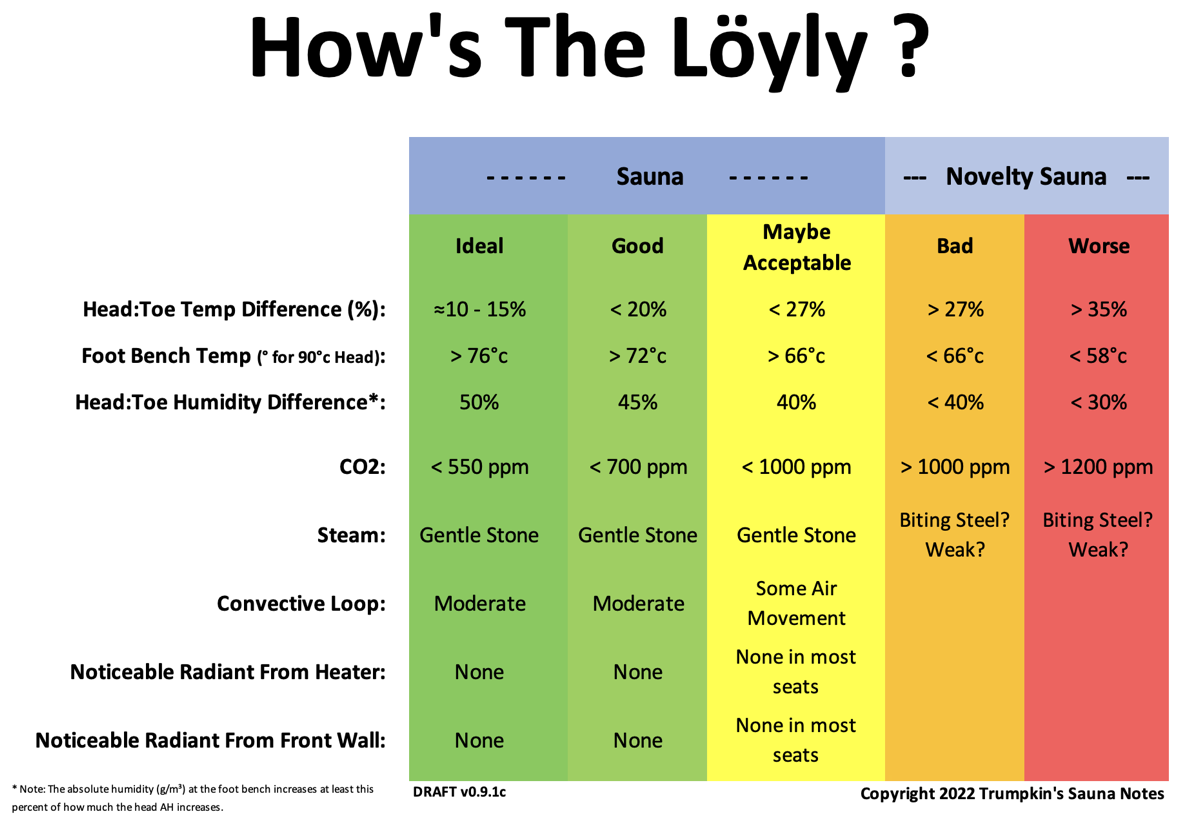
At a minimum all manufacturers should publish temperature results from #1. This is easy and inexpensive for them to accomplish.
This should provide consumers with some accurate objective information upon which to base decisions. Tests should ideally be conducted by an independent agent to insure impartiality. More details on how to take these measurements here.
Consumers: Ask Manufacturers for Head and Toe temperatures of any sauna you are considering. If they don’t want to provide it, move on.
Note: In a small space it is impossible to achieve very low radiant heat, bathers are simply too close to the heater. This will be the case with a custom built sauna or a kit sauna. A higher ceiling helps, but only a little.
Barrels
Barrels of less than 9-10’ in diameter are inherently bad for sauna so there is no need to review them. More: Notes On Barrels.
Vendor Integrity
I really dislike people who lie or are misleading and the U.S. sauna industry is one of the most dishonest and misleading industries I’ve encountered. They make car sales folks seem like Pat Boone. Two key areas are false health claims and the number of people who can fit in a sauna. On the latter I believe that every manufacturer should include a photo of their sauna with the stated number of average American adults (5’9” / 197lbs / 40” waist). More: Quackery & Sauna Frauds
Winner: Finnleo – Finnleo makes some questionable health claims but perhaps not as outlandish or misleading as others. Their estimates for the number of people in a sauna might be tight but not unreasonable. They get some credit for not trying to foist barrels off on unsuspecting consumers but get dinged for claiming that IR is a sauna.
Harvia / Almost Heaven – Their health page is more honest than Finnleo but elsewhere on their site they make claims of weight loss and toxin release in a manner that is misleading. Their claims of how many people can fit in to their saunas is grossly misleading and dishonest. I also dislike their fake pricing with everything always ‘on sale’.
Salus / Enlighten / Sauna Place – Burn 1200 calories in 30 minutes? Do you really trust these people? Do you really want to buy from someone who lies like that?
——————— Some Reviews ———————
Finnleo Northstar 4’x4′
https://www.finnleo.com/northstar-44
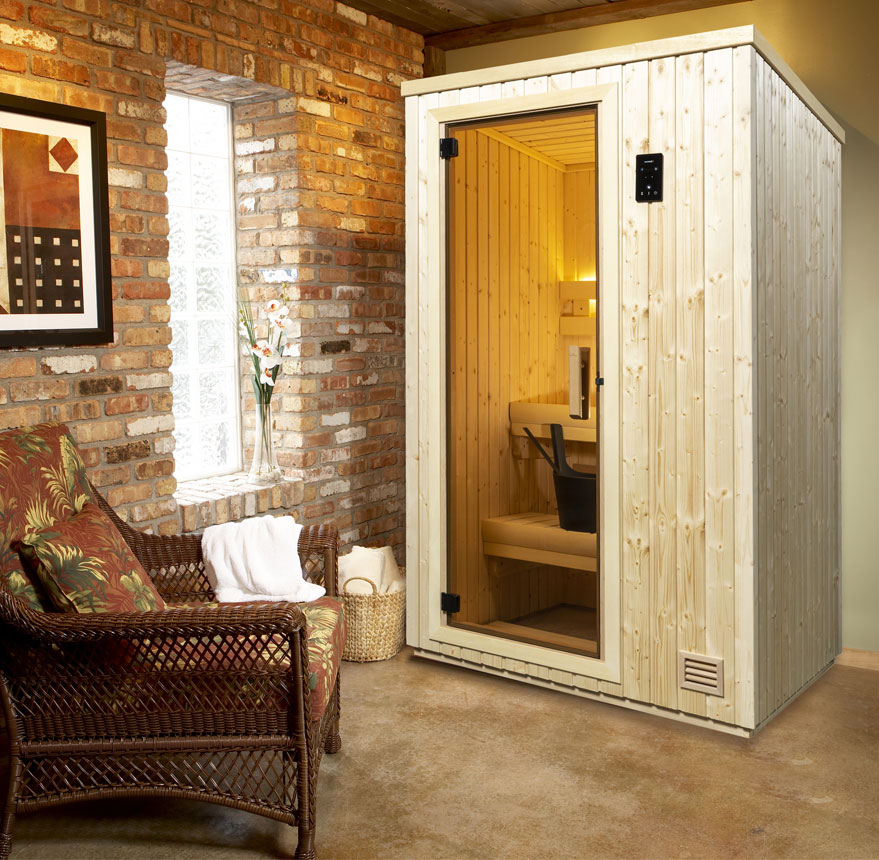
Big Issues
No Ventilation – The Northstar has convective airflow for cooling the heater high-limit sensor. It lacks any ventilation for bathers. Bathers will experience high levels of CO2 which will result in their leaving the sauna from the beginnings of suffocation rather than experiencing proper heat and löyly. Bathers may also experience lightheadedness, dizziness, and other effects of hypercapnia.
This sauna will not expel humidity quickly so rather than multiple rounds of contrasting löyly this sauna will have ever increasing humidity which is not comfortable nor hygienic.
See the Ventilation article linked in the menu above for more.
Benches/Ceiling are too low – The Foot Bench should be above the top of the stones and above the lower third of the space. Bathers in the Northstar will have their feet and legs in the cold zone, experience uneven head to toe temps and cold feet and legs.
The lower bench may also develop mold and bacteria since it is unlikely to ever get hot enough (55-65°c for 20 minutes) to kill these.
Too Little Volume ? – This sauna has the minimum volume recommended for one person. While two people can squeeze in they will not have sufficient/healthy air volume.
Limited Heat Cavity – Greater loss of heat when door opens and longer time to recover.
Heater Is Too Close to Bathers – Bathers will experience more direct radiant heat than is normally desired.
No Air Gap on rear of benches – Larger air gaps on the back of benches allow convective heat to help warm bathers backs.
Fixing The Northstar 4×4
Purchasers should do two things to improve the Northstar:
#1 – Add proper ventilation for bathers including a supply vent above the heater and a mechanical exhaust below the foot bench (cheated away from the heater).
#2 – Add a larger air gap to the rear of the benches by removing one slat.
Almost Heaven Saunas – Auburn / Madison / Bluestone 2-3 Person Indoor Sauna
And similarly the Rainelle / Grayson 4-person and Bridgeport 6-person.
Auburn 2-3 Person Indoor Sauna
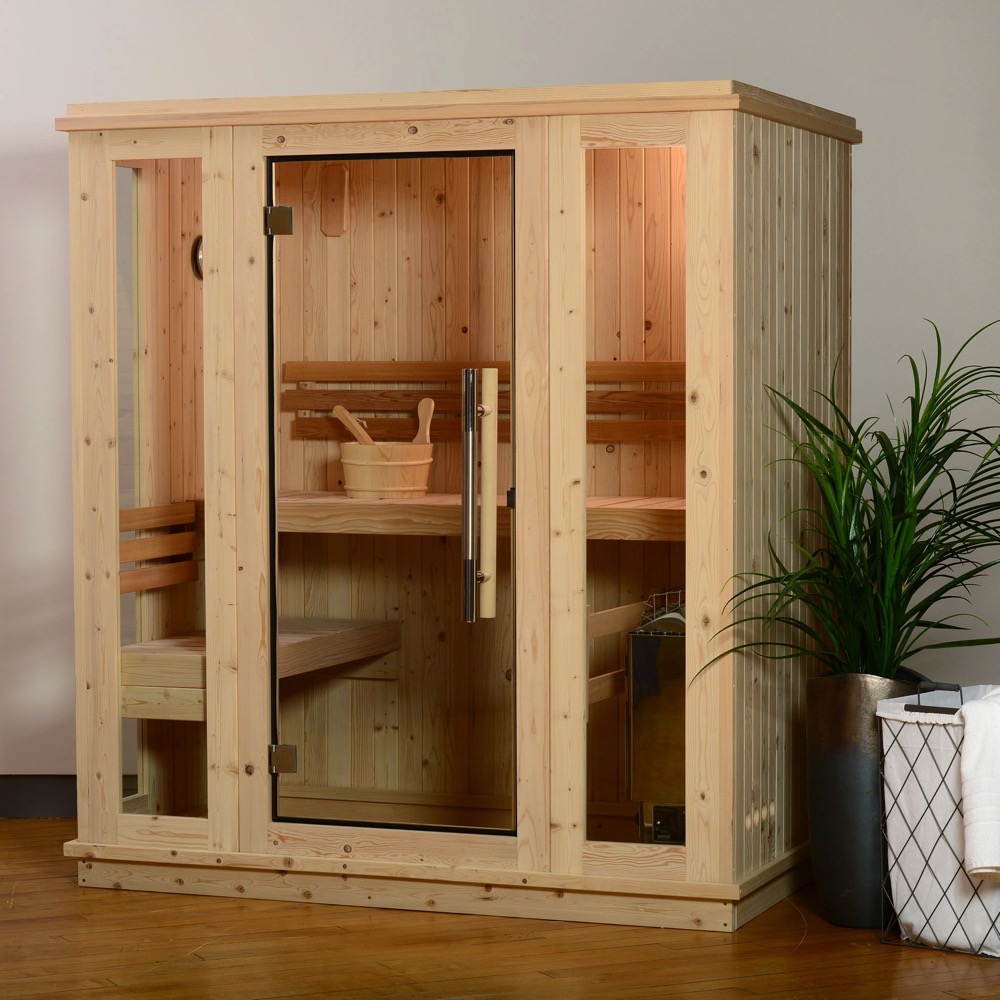
These are perhaps best described as American pseudo-saunas. This is not anything you are likely to see in Finland, Sweden, Germany or elsewhere outside of the U.S. as buyers there know that in this booth they will have cold feet, bad air and no löyly.
Big Issues
No Ventilation – These have convective airflow for cooling the heater high-limit sensor. It lacks sufficient ventilation for bathers. Bathers will experience high levels of CO2 which will result in their leaving the sauna from the beginnings of suffocation rather than experiencing proper heat and löyly. Bathers may also experience lightheadedness, dizziness, and other effects of hypercapnia.
This sauna will not expel humidity quickly so rather than multiple rounds of contrasting löyly this sauna will have ever increasing humidity which is not comfortable nor hygienic.
See the Ventilation article linked in the menu above for more.
Benches/Ceiling are too low – The Foot Bench should be above the top of the stones and the sitting bench 16-18” above that. The bather on the upper bench of this sauna will have cold feet (when feet are more than ≈20°c cooler than the bathers head). The lower bench may also develop mold and bacteria since it is very unlikely to ever get hot enough (55-65°c for 20 minutes) to kill these.
The lack of a heat cavity above the door means that a significant amount of heat will escape every time the door is opened. Besides being uncomfortable for others and taking longer to heat up, this wastes electricity and increases operating costs.
Heater Placement – The heater should be on the wall opposite the benches (e.g., on the same wall as the door) in order to produce the convective loop that is critical for having a löyly cavity for bathers and to reduce undesirable direct radiant heat on bathers. Bathers side facing the heater may roast.
Too Little Volume – Its 121 cu ft of interior volume is only enough for one person to breath safely. For two people it should have a minimum of 175 cu ft but ideally 350 cu ft. For three people 245-500 cu ft.
Deceptive Advertising – This is realistically an uncomfortable one person booth, not a three person sauna. It has physical seating for only one person and enough interior volume for only one person to breath comfortably. Similarly the Rainelle & Grayson are 1-2 person units.
But even with just one person there is only 15” of foot bench so one of their feet will be dangling or they’ll have to twist sideways for both feet to be on the too narrow foot bench.
Almost Heaven says that two can fit on the upper bench and one on the lower. At a minimum you want 24” of sitting bench (more for overweight Americans) and foot bench per person. This appears to have much less than the 48” needed for two people due to the heater. The second person will have no foot bench so their feet will be dangling in mid air, they will be pushed up against the heater so they’ll get a lot of uncomfortable direct radiant heat and unless both people are fairly thin they will be pushed up against each other.
At 20” wide the lower bench (third person) isn’t really even wide enough for a single person to sit comfortably much less a person sitting and feet of the person above. Someone on the lower bench would be sitting on someone’s feet which isn’t comfortable for either and they are almost entirely in the cold zone.
Almost Heaven should include a photo of 3 average size American adults sitting in this booth.
It would have been far better had they included a traditional foot bench as in the Finnleo Northstar or perhaps included a portion of foot bench next to this that can slide out to act as a traditional foot bench.
Other Issues
Too Much Glass / Too Little Wood – This will effect bather comfort as wood is hygroscopic and needed to help even out temps and humidity.
Not Wide Enough To Lay Down
Bench Air Gaps may be too small – This will limit proper airflow and steam will not descend below the sitting bench to bathers legs.
No Air Gap on rear of benches – Larger air gaps on the back of benches allow convective heat to help warm bathers backs.
No Floor – Some models do not have a floor.
Almost Heaven Saunas – Allegheny 6-Person Cabin Sauna
Allegheny 6 Person Cabin Sauna
This is perhaps best described as an American warm room with bad air – an American pseudo-sauna. This is not anything you are likely to see in Finland, Sweden or Germany – buyers there know that in this cabin they will have cold feet, bad air and so no löyly.
Big Issues
Deceptive Advertising – This is a two person sauna, not six. It has only enough interior volume (8 cubic meters) for two people (minimum 3 m³ / person) to breath safely and has physical seating for only three people.
Almost Heaven says that three people can fit on the upper sitting bench and three on the lower foot bench but the foot bench is only 19” deep which does not provide enough space for feet and people to sit comfortably and anyone sitting that low will experience quite extreme stratification. Even if you squeeze six people in they would be breathing each others exhaled breath and that’s not healthy nor enjoyable.
No Ventilation – The Allegheny has convective airflow for cooling the heater high-limit sensor. It lacks any ventilation for bathers. Bathers will experience high levels of CO2 which will result in their leaving the sauna from the beginnings of suffocation rather than experiencing proper heat and löyly. Bathers may also experience lightheadedness, dizziness, and other effects of hypercapnia.
This sauna will not expel humidity quickly so rather than multiple rounds of contrasting löyly this sauna will have ever increasing humidity which is not comfortable nor hygienic.
See the Ventilation article linked in the menu above for more.
Benches/Ceiling are too low – The Foot Bench should always be above the top of the stones and above the lower third of the space. Bathers in the Allegheny will have their feet and legs in the cold zone, experience uneven head to toe temps and cold feet and legs.
The lower bench will likely develop mold and bacteria since it is unlikely to ever get hot enough (55-65°c for 20 minutes) to kill these.
Too Little Volume – A sauna should have a minimum of 3 m³ (105 cubic feet) per person. Sauna builders in Scandinavia aim for 1.5x to twice that amount of interior volume per bather. Less volume results in high levels of CO2 (people rebreathing others exhaled breath) and uneven heat. The Allegheny has a total of 7.98 m³ (273 cubic feet) which is enough for two people. For six people this should be at least twice as large and ideally 4x as large.
No Vestibule/Changing/Shower Room – Door openings, particularly during colder weather, will result in greater heat loss and uncomfortably cold drafts on bathers.
Lock On The Door – There should never be a lock on the hot room door. For safety hot room doors should always be able to be opened by simply pushing on them.
Other Issues
Limited Heat Cavity – Greater loss of heat when door opens and longer time to recover.
Poor Ceiling Shape – This will result in unnecessary extra heat above bathers heads and the angle at the peak will decrease the convective loop in the löyly cavity resulting in greater stratification and discomfort for bathers. Making half to three-quarters of the ceiling flat would help.
Heater Is Too Close to Bathers – Bathers will experience more direct radiant heat than is normally desired.
Lack of Insulation / Thin Walls – The walls will be colder which will result in bathers having colder backs. The Allegheny will take longer to heat up and use more energy than a properly insulated sauna.
As a money saving element I do not believe this is necessarily a bad construction approach though and this is much less of a drawback than any of the big issues above. While a properly insulated sauna would certainly be better, particularly in colder climates, this sauna with proper ventilation and higher benches would likely be much better than a well insulated sauna with poor ventilation and too low of benches.
Bench Air Gaps may be too small – This will limit proper airflow.
No Air Gap on rear of benches – Larger air gaps on the back of benches allow convective heat to help warm bathers backs.
Fixing The Allegheny
In order of importance to achieving a proper sauna experience:
#1 – Add proper ventilation for bathers including a supply vent above the heater (wood & electric) and a mechanical exhaust below the foot bench (electric).
#2 – Add 18-24” to the overall height and raise the benches. This will also create a better heat cavity.
#3 – Add a vestibule and remove the lock from the hot room door. Or, include the capability for a vestibule to be easily added at a later date.
#4 – Add a flat segment to the ceiling.
#5 – Add a larger air gap to the rear of the benches and possibly increase the air gaps of the benches themselves if too small.
With these changes I believe this would be a relatively good sauna for two people and occasionally three or maybe four, particularly for milder climates that don’t get too cold.
Almost Heaven could plan this so that they can offer a vestibule/changing/shower as add-on kits that can be added at a later date. And similarly a porch (with roof) add-on so that eventually the owner could have a proper Finnish sauna with a hot room, changing room, shower and covered porch. An option for adding a window or two in the sauna hot room would be good.
Almost Heaven – Appalachia 6-person Sauna
Also: Salus Olympia 6-person sauna.
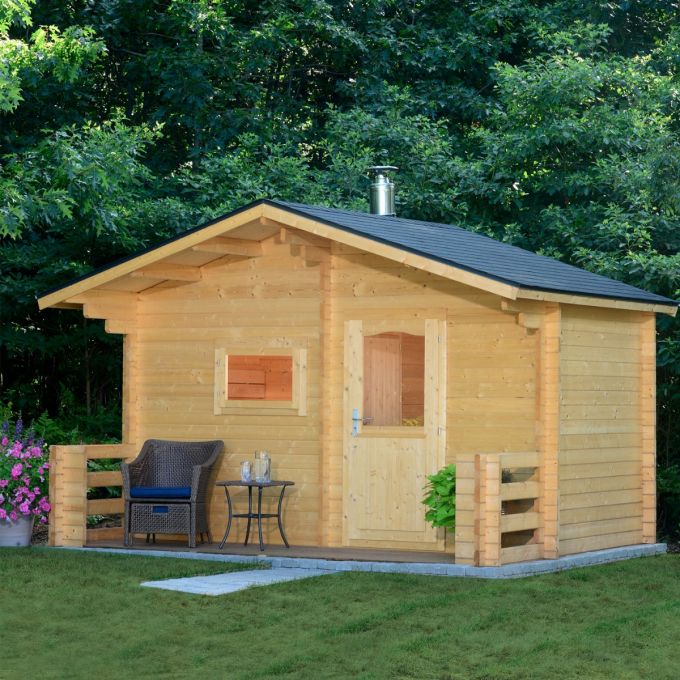
This is a very cute cabin but will make for a quite poor sauna. They do get credit for having a vestibule and porch!
The Issues
Deceptive Advertising – This is a three person sauna, not six. It has only enough interior volume for three people to breath safely and has physical seating for only three people. With three people sitting on the sitting bench and feet on the foot bench there will not be space for three more people to sit comfortably on the lower foot bench.
No Ventilation – This appears to have only convective airflow for the heater and lacks any fresh air ventilation for bathers. Bathers will experience high levels of CO2 which will result in their leaving the sauna from the beginnings of suffocation rather than experiencing proper heat and löyly. Bathers may also experience lightheadedness, dizziness, and other effects of hypercapnia.
This sauna will not expel humidity quickly so rather than multiple rounds of enjoyable contrasting löyly this sauna will have ever increasing humidity which is not comfortable nor hygienic.
See the Ventilation article linked in the menu above for more.
Benches/Ceiling are too low – The Foot Bench should be above the top of the stones / lower third. Bathers in the Appalachia will have their feet and legs in the cold zone, experience uneven head to toe temps and cold feet and legs.
The lower bench may also develop mold and bacteria since it is very unlikely to ever get hot enough (55-65°c for 20 minutes) to kill these.
Too Little Volume – A sauna should have a minimum of 2 m³ (70 cubic feet) per person plus an additional 1 m³ (35 cubic feet) for the heater. Sauna builders in Scandinavia aim for twice that amount of interior volume per bather. Less volume results in high levels of CO2 (people rebreathing others exhaled breath). The Appalachia has a total of 7.2 m³ which is the minimum for three people. For the claimed six people this should be at least twice as large and ideally 4x as large.
Poor Ceiling Shape – The bulk of the heat will be up above the side opposite bathers. This shape will also reduce or likely totally eliminate the critical upper convective loop so this sauna lacks a löyly cavity resulting in greater stratification and discomfort for bathers. The ceiling should be generally flat and about 260cm above the floor so that the foot bench can be above the top of the stones.
Heater Is Too Close to Bathers – Bathers will experience more direct radiant heat than is desired.
Limited Heat Cavity – Greater loss of heat when door opens and longer time to recover.
Lack of Insulation / Thin Walls – The walls will be colder which will result in bathers having colder backs. The Olympia will take longer to heat up and use more energy than a properly insulated sauna.
However, as a money saving element I do not believe this is necessarily a bad construction approach and this is much less of a drawback than any of the bigger issues above. While a properly insulated sauna would certainly be better, particularly in colder climates, this sauna with proper ventilation and higher benches would likely be much better than a well insulated sauna with poor ventilation and too low of benches.
Bench Air Gaps may be too small – This will limit proper airflow.
No Air Gap on rear of benches – Larger air gaps on the back of benches allow convective heat to help warm bathers backs.
Fixing The Appalachia
In approximate order of importance to achieving a proper sauna experience:
#1 – Add proper ventilation for bathers including an adjustable fresh air supply vent above the heater (wood & electric) and a mechanical exhaust below the foot bench (electric).
#2 – Increase the ceiling height so that the foot bench is above the top of the stones. This will also create a better heat cavity.
#3 – Flatten the ceiling. Very slightly peaked or coved works well (with the peak no more than about 20cm above the top of the walls) but not as steep as this one nor one-sided as this one. While not ideal, even just adding a slope to the door/heater side of the ceiling would help.
#4 – Increase the depth so that bathers are a little further back from the heater or include a baffle wall by the heater to reduce direct radiant heat on bathers.
#5 – Add a larger air gap to the rear of the benches and possibly increase the air gaps of the benches themselves if too small.
With these changes I believe this would be a relatively good sauna for two or three people, particularly for milder climates that don’t get too cold.
Sunray – Baldwin 2-Person Sauna
Sunray Baldwin 2-Person Traditional Finnish Sauna
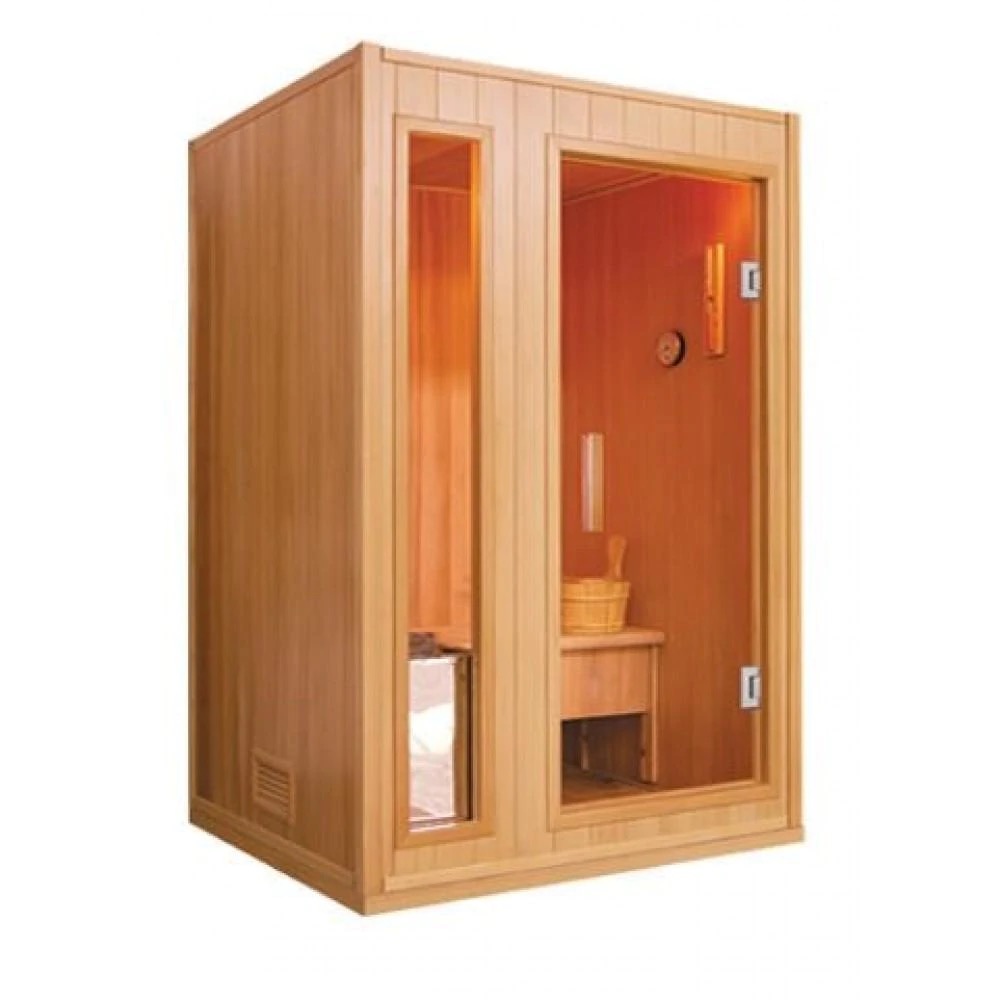
This is not really a sauna at all, much less a ‘Traditional Finnish Sauna’ as advertised. According to the Sunray documentation it can only get to a maximum temp of 80°c (176°f) which is below the 80-105°c recommended by the Finnish Sauna Society and the International Sauna Association. But worse, due to the extremely low bench and being so much below the ceiling, the bather will experience much lower temps. All of the heat will be above their heads and rather than the 80-105°c temps recommended the bather will be closer to about 60°c at best.
Big Issues
Deceptive Advertising – This is a one person sauna, not two. It does not have the volume nor seating capacity for more than one. The bench is wide enough for two people but the heater is in the way of a second person.
No Ventilation – The Baldwin has convective airflow for cooling the heater high-limit sensor. It lacks any ventilation for bathers. The bather will experience high levels of CO2 which will result in their leaving the sauna from the beginnings of suffocation rather than experiencing proper heat and löyly. Bathers may also experience lightheadedness, dizziness, and other effects of hypercapnia.
This sauna will not expel humidity quickly so rather than multiple rounds of contrasting löyly this sauna will have ever increasing humidity which is not comfortable nor hygienic.
See the Ventilation article linked in the menu above for more.
Bench is much too low – The Foot Bench (floor in this case) should be above the top of the stones and the sitting bench at least 18” above that. Here they are at least 22” too low as well as far below the ceiling. The bather will have their entire lower body in the cold zone, experience overall low temps, uneven head to toe temps and cold lower body.
The floor may also develop mold and bacteria since it is very unlikely to ever get hot enough (55-65°c for 20 minutes) to kill these.
Too Little Volume – A sauna should have a minimum of 70 cubic feet per person plus an additional 35 cubic feet. This sauna barely has enough volume for one person and not enough for the advertised two people.
Other Issues
Limited Heat Cavity – Greater loss of heat when door opens and longer time to recover.
Bench Air Gaps may be too small or non-existent – This will limit proper airflow and be uncomfortable.
No Air Gap on rear of benches – Larger air gaps on the back of benches allow convective heat to help warm bathers backs.
Heater Is Too Close to Bathers – Bathers will experience more direct radiant heat than is normally desired.
Dundalk Luna (CTC22LU)
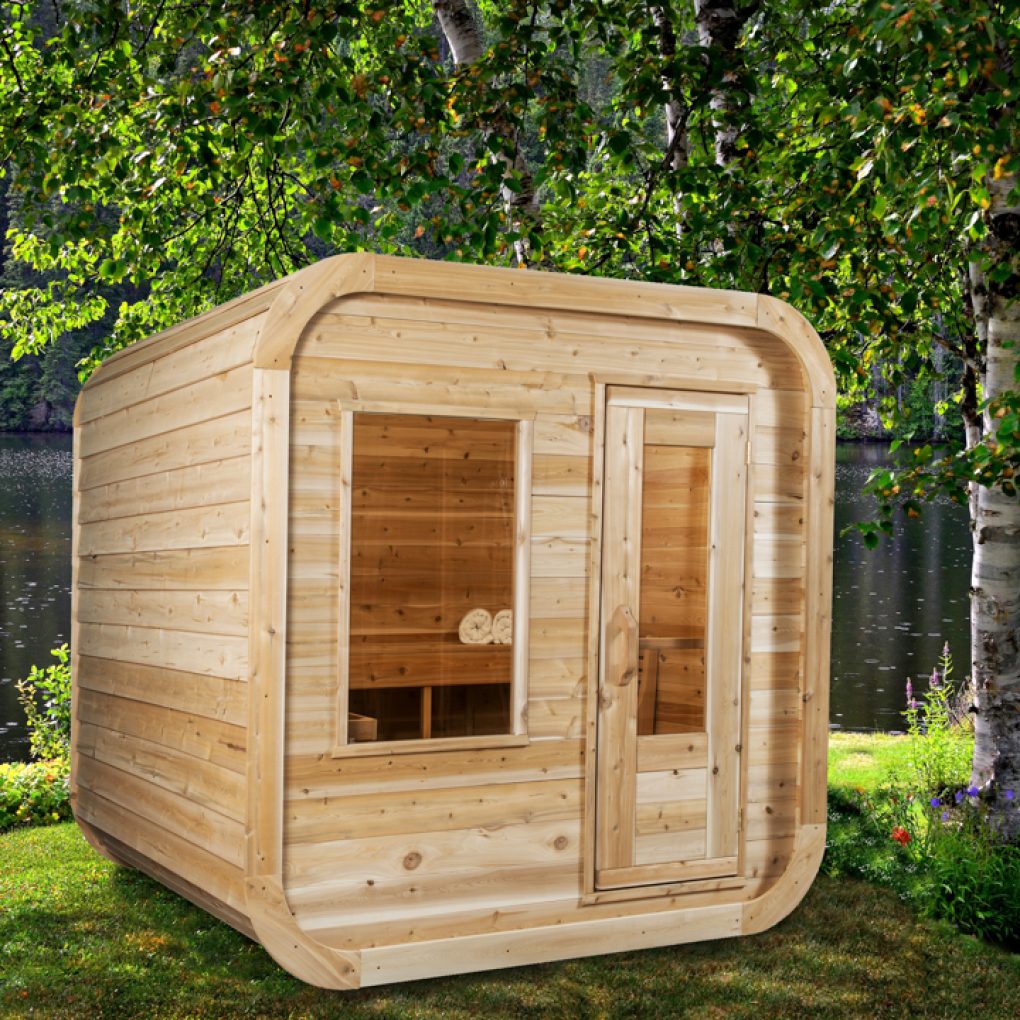
NOTE: I wrote this review based on the specifications on their web page. I’ve since learned that these specifications are inaccurate and misleading – that the interior of the sauna is only 204cm high and not 246cm as their drawings indicate.
We do NOT recommend this unit nor doing business with Dundalk nor Leisurecraft.
This is perhaps the most consumer fixable kit sauna available in North America and the only one I’d recommend (with reservations). Building your own will still result in a much better sauna experience though and I still recommend that until kit sauna builders in North America figure out how to build saunas correctly.
Dundalk’s other saunas are quite bad and their Mini Pod downright awful and perhaps the rare case of something being worse than a barrel indicating that Dundalk and Leisurecraft do not understand sauna but here perhaps accidentally produced something fixable.
This sauna can seat 3 people and will have about 100 cubic feet of volume per person which is good. The sitting bench is long enough for someone to lay on but too narrow.
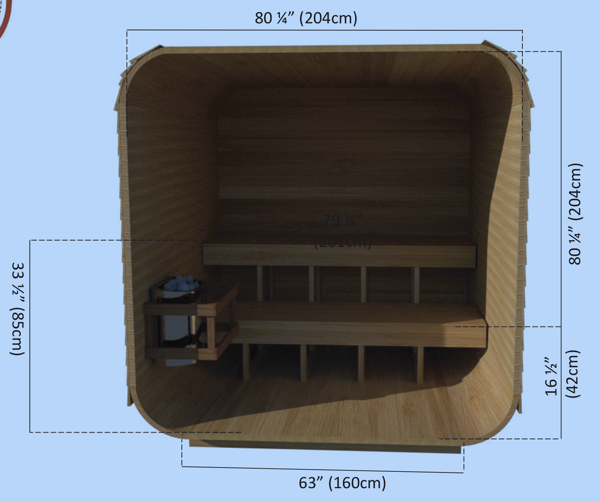
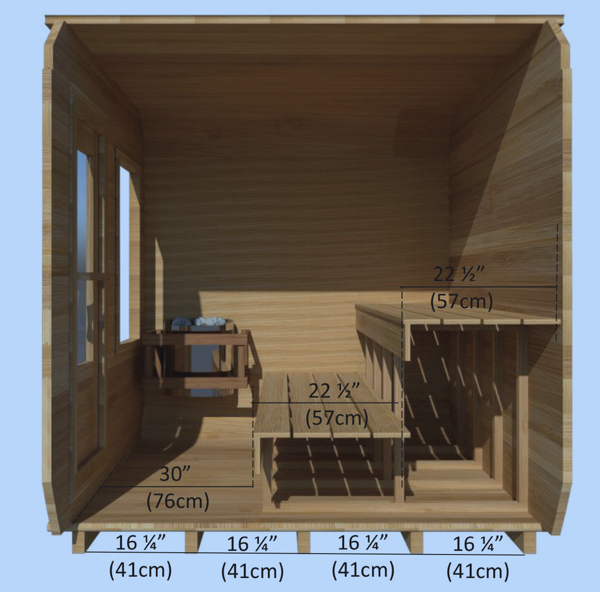
Big Issues
No Ventilation – The Luna has convective airflow for cooling the heater high-limit sensor. It lacks any ventilation for bathers. Bathers will experience high levels of CO2 which will result in their leaving the sauna from the beginnings of suffocation rather than experiencing proper heat and löyly. Bathers may also experience lightheadedness, dizziness, and other effects of hypercapnia.
This sauna will not expel humidity quickly so rather than multiple rounds of contrasting löyly this sauna will have ever increasing humidity which is not comfortable nor hygienic.
See the Ventilation article linked in the menu above for more.
Benches/Ceiling are much too low – The Foot Bench should be above the top of the stones. Bathers in the Luna will have their feet and legs in the cold zone, experience uneven head to toe temps and cold feet and legs. The benches are too low relative to the ceiling so all of the heat will be above bather’s heads.
The lower bench may also develop mold and bacteria since it is very unlikely to ever get hot enough (55-65°c for 20 minutes) to kill these.
No Vestibule/Changing Room – Door openings, particularly during colder weather, will result in greater heat loss and uncomfortably cold drafts on bathers.
Limited Heat Cavity – Greater loss of heat when door opens and longer time to recover.
Heater Is Too Close to Bathers – Bathers will experience more direct radiant heat than is normally desired.
Lack of Insulation / Thin Walls – The walls will be colder which will result in bathers having colder backs. The Luna will take longer to heat up and use more energy than a properly insulated sauna.
As a money saving element I do not believe this is necessarily a bad construction approach though and this is much less of a drawback than any of the bigger issues above. While a properly insulated sauna would certainly be better, particularly in colder climates, this sauna with proper ventilation and higher benches would likely be much better than a well insulated sauna with poor ventilation and too low of benches.
Bench Air Gaps appear too small – This will limit proper airflow.
No Air Gap on rear of benches – Larger air gaps on the back of benches allow convective heat to help warm bathers backs.
Roof Leak? – The design of the flat roof looks like it could result in leaks. Extending the EDPM beyond all edges could possibly help.
Cedar – This wood can be quite strong fragrance which can detract from the sauna experience. Sauna’s in Finland and elsewhere outside of North America use less fragrant wood like spruce.
Fixing The Luna
The Luna has one advantage – interior height. A consumer can likely fix the worst of the problems (#’s 1-4 below and if handy 5 & 6) and have a relatively good sauna.
#1 – Add proper ventilation (50-80 actual CFM) including a supply vent above the heater and an electric powered mechanical exhaust below the foot bench. See Sauna Ventilation in top menu.
#2 – Raise the benches. The sitting bench should be 100-122 cm (42-48”) below the ceiling. Here I’d recommend setting it at 44” (112 cm) below or perhaps a bit more if taller people will be using it. A step or wood stool should be added for easier access to the benches.
#3 – Make the upper bench 24-26” deep so that someone can more comfortably lay on it. The lower bench can be 18-20”.
#4 – Narrower bench boards, larger air gaps and an air gap on the back of the bench would help.
#5 – Lower the height of the door to create a larger heat cavity.
#6 – Add a vestibule. Or, include the capability for a vestibule to be easily added at a later date.
#7 – Offer a non-cedar option.
These changes will vastly improve this unit and I believe this would be a relatively good sauna for three people, particularly for milder climates that don’t get too cold.
Family Handyman DIY Kit
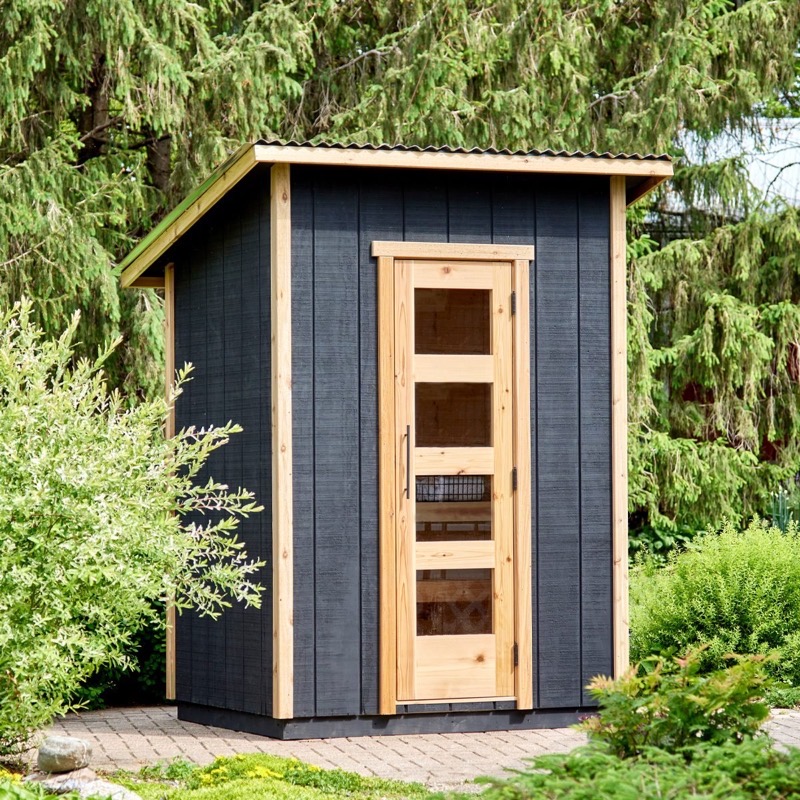
This is a great idea for a construction method – but not a good sauna. I think that applying proper sauna principles to this construction style could be a good option for many people. But this is not it.
Big Issues
Deceptive Advertising – They advertise this as a 4-person. It has seating for only 2 people and volume for only 1. Anyone building this should be aware of this and plan accordingly for proper bench space and overall volume. A 4-person sauna is typically 8’x8’x8.5′
No Ventilation – Bathers will experience high CO2 and no exhaust of steam, PM, Pathogens or VOCs. This should have proper ventilation.
Benches & Ceiling Too Low – Bathers will have cold feet, no heat cavity above the door and the foot bench is likely to develop bacteria and mold due to lack of heat to kill them.
Roof Sloped The Wrong Way – There will be no convective loop so no löyly cavity. With a sloped roof the high side should always be on the bench wall and the low side the heater wall.
Too Little Volume – The volume is fine for one person but too little overall volume to be healthy for more than one. A sauna should have a minimum of 100 cubic feet per breathing person though 150-200 is better.
Heater Too Close To Bathers – Bathers will experience radiant heat and heat rising in to their face.
Too Small – Saunas smaller than about 6×7 do not have enough area for a convective loop to form so bathers experience uneven temps and steam on their body which becomes uncomfortable.
Limited Bench Gaps – Reduce airflow, steam and löyly to lower legs and feet.
No Gap Behind The Sitting Bench – Reduce airflow and steam on bathers back.
Poor Insulation – There is a LOT of thermal bridging with this design (search ‘framing factor’ for more) so the walls could be cold resulting in bathers experiencing chilly backs and increased stratification. This will also be energy inefficient. This should use foil faced PIR panels on the inside rather than paper foil. Insulation used in cavities should be rated for at least 240°f. Mineral wool would be a better choice for cavity insulation.
Wall Air Gap At Floor & Ceiling – There should be air gaps at the floor and ceiling for air to flow behind the interior cladding. E.G., the interior cladding should not go all the way to the floor nor ceiling. Otherwise moisture gets trapped in that space leading to unhealthy mold and rot.
Heater s/b on the Door Wall – Ideally the heater should be on the wall opposite the bench wall (and much further away) in order to produce a good convective loop.
Poor Vapor Sealing? – Saunas can be surprisingly high pressure due to heat (stack effect) and especially when steam is produced. This could drive moist air through the corner joints where the panels meet. If this moist air goes to the outside then it shouldn’t be a problem but if it gets trapped in the wall cavity then it would likely result in mold and rot. Some way to either better seal these or insure that any moist air flowing through goes to the outside might be good.
Air Gap Below Steel Roof? – The corrugated steel may provide enough air space for the roof structure to dry but I would provide for some form of gap using lathe or something like cedar breather.
Plywood Door? – Bad idea. There’s a slight risk from off-gassing but a high risk that the door will delaminate or warp due to the heat & humidity of a sauna. (Note: This was corrected when the author had problems).
Fixing The Family Handyman DIY Sauna
Firstly, see the above and read through Trumpkin’s Notes on Building a Sauna. Some quick thoughts for a better design;
#1 – Add proper ventilation! – (25 CFM / Person) including a supply vent above the heater and an electric powered mechanical exhaust below the foot bench (for electric). See Sauna Ventilation in top menu. This is overwhelmingly the most important.
#2 – Fix The Roof Slope – The interior ceiling should either be flat or should slope the opposite of what is shown (high side should be bench wall, low side door/heater wall).
#3 – Raise The Ceiling – The ceiling should ideally be ≈8.5’ high so that the benches can be higher. The foot bench should ideally be 34” high with the sitting bench 16-18″ above that and the ceiling 44-48″ above that. This is really tight in a 4’x4’ sauna (and why such a small sauna is so rare outside of the U.S.) but can be done (or close to it) w/ a 2’ deep sitting bench, 14” deep foot bench and 10” step.
#4 – Fix Dimensions – Larger Is Better. Increasing the depth is top priority as this will get the heater further from bathers and allow for easier access to higher benches. A 6’x7’ interior is the realistic minimum for any sauna but larger would be better.
If You Already Have This Sauna
We’ve seen a number of posts from people who’ve built this sauna and then found that it doesn’t work well. What appears to be happening (besides the problems listed above) is that the heat is getting jammed up in the top of it so not only is it a poor convective loop but pretty much no convective loop.
A couple of things you can do if you’ve already built it:
#1 – Add proper ventilation! – (25 CFM / Person) including a supply vent above the heater and an electric powered mechanical exhaust below the foot bench (for electric). See Sauna Ventilation in top menu. This is overwhelmingly the most important.
#2 – Add a bit of flat or cove crown moulding across the top of the door wall – This isn’t likely to create a proper convective loop but should at least help keep the heat from getting jammed up as it’s seeming to do. See the red line below for approximate positioning.
